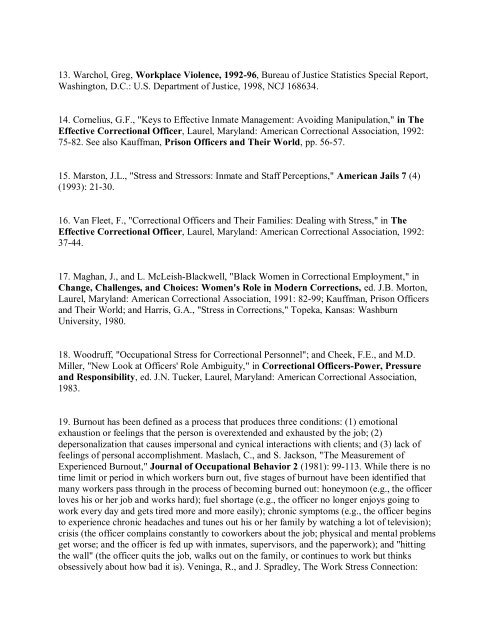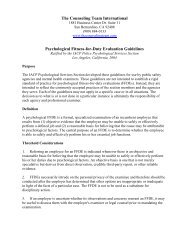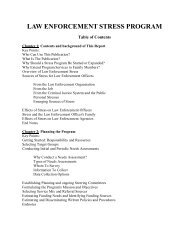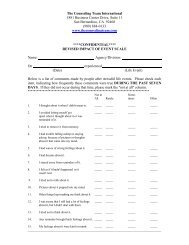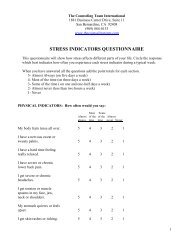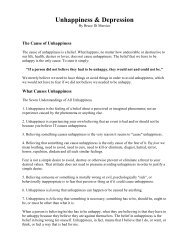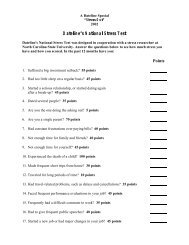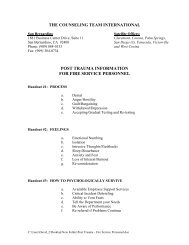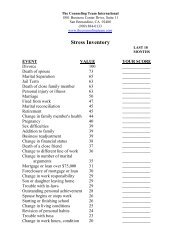13. Warchol, Greg, Workplace Violence, 1992-96, Bureau of Justice Statistics Special Report,Washington, D.C.: U.S. Department of Justice, 1998, NCJ 168634.14. Cornelius, G.F., "Keys to Effective Inmate Management: Avoiding Manipulation," in <strong>The</strong>Effective Correctional Officer, Laurel, Maryland: American Correctional Association, 1992:75-82. See also Kauffman, Prison Officers and <strong>The</strong>ir World, pp. 56-57.15. Marston, J.L., "Stress and Stressors: Inmate and Staff Perceptions," American Jails 7 (4)(1993): 21-30.16. Van Fleet, F., "Correctional Officers and <strong>The</strong>ir Families: Dealing with Stress," in <strong>The</strong>Effective Correctional Officer, Laurel, Maryland: American Correctional Association, 1992:37-44.17. Maghan, J., and L. McLeish-Blackwell, "Black Women in Correctional Employment," inChange, Challenges, and Choices: Women's Role in Modern Corrections, ed. J.B. Morton,Laurel, Maryland: American Correctional Association, 1991: 82-99; Kauffman, Prison Officersand <strong>The</strong>ir World; and Harris, G.A., "Stress in Corrections," Topeka, Kansas: WashburnUniversity, 1980.18. Woodruff, "Occupational Stress for Correctional Personnel"; and Cheek, F.E., and M.D.Miller, "New Look at Officers' Role Ambiguity," in Correctional Officers-Power, Pressureand Responsibility, ed. J.N. Tucker, Laurel, Maryland: American Correctional Association,1983.19. Burnout has been defined as a process that produces three conditions: (1) emotionalexhaustion or feelings that the person is overextended and exhausted by the job; (2)depersonalization that causes impersonal and cynical interactions with clients; and (3) lack offeelings of personal accomplishment. Maslach, C., and S. Jackson, "<strong>The</strong> Measurement ofExperienced Burnout," Journal of Occupational Behavior 2 (1981): 99-113. While there is notime limit or period in which workers burn out, five stages of burnout have been identified thatmany workers pass through in the process of becoming burned out: honeymoon (e.g., the officerloves his or her job and works hard); fuel shortage (e.g., the officer no longer enjoys going towork every day and gets tired more and more easily); chronic symptoms (e.g., the officer beginsto experience chronic headaches and tunes out his or her family by watching a lot of television);crisis (the officer complains constantly to coworkers about the job; physical and mental problemsget worse; and the officer is fed up with inmates, supervisors, and the paperwork); and "hittingthe wall" (the officer quits the job, walks out on the family, or continues to work but thinksobsessively about how bad it is). Veninga, R., and J. Spradley, <strong>The</strong> Work Stress Connection:
How to Cope with Job Burnout, New York: Ballantine Books, 1981; Cornelius, G., StressedOut: Strategies for Living and Working with Stress in Corrections, Laurel, Maryland:American Correctional Association, 1994.20. Slate, R.N., "Stress Levels of Correctional Personnel: Is <strong>The</strong>re a Difference Between theSexes?" Paper presented at the Academy of Criminal Justice Sciences annual meeting in KansasCity, Missouri, March 20, 1993.Do Midlevel Correctional Managers Experience Stress?Midlevel managers (lieutenants and captains) interviewed for this publication report theyexperience several types of stress:Dealing with subordinates (in particular line officers acting without consultation), poorline officer productivity, the need to discipline or terminate officers, and contending withunderstaffing-including having to ask stressed--out line officers to work overtime.Attempting to follow unclear policies and procedures and frequent modifications topolicies and procedures as top-level supervisors change their minds or are replaced.Completing all the required documentation and paperwork--yet still being on the line tosupervise and be seen by line officers.A lieutenant with a State department of corrections reported that--<strong>The</strong> stress is worst for middle management: You decide on staff deployment and everyone looksto you for guidance. You make the critical decisions; as watch commander, you run the prison.On two shifts out of three, I'm the highest ranking person in the facility because the higher-upsleave at 4:00 p.m. It's a tremendous responsibility. <strong>The</strong> decisions are tough. Also, someone isMonday morning quarterbacking you, your decisions are scrutinized, and they're life-and-deathdecisions.Top correctional administrators also experience stress. Wardens, deputy wardens, and jailadministrators may be saddled with a "24/7" commitment-carrying a beeper around the clock.<strong>The</strong>y have to deal with typically adversarial labor relations with the officers' union, staff hostilityor mistrust, pressures from central administration, political scapegoating, and media exposure.Furthermore, top-level administrators are typically reluctant to share their feelings of uncertainty,helplessness, or inadequacy with anyone for fear of appearing weak, incompetent, or indecisive.Which Officers Are Most Likely to Experience Stress?According to one researcher, "At this point, there seems to be no clear consensus as to whichfactors can be consistently correlated with stress in corrections."[a] Some studies have found thatofficers working higher security level institutions or units experience more stress than officersworking medium or minimum security areas,[b] while other studies have found no differences instress levels among security levels.[c] Staffing an administrative segregation unit can,paradoxically, feel less stressful than working on other units (because inmates are locked down
- Page 1 and 2: ISSUES AND PRACTICESAuthor: Peter F
- Page 3 and 4: The various program options present
- Page 5 and 6: Program overviewCollaboration with
- Page 7 and 8: An unproven interventionPotential b
- Page 9 and 10: Executive SummaryAddressing Correct
- Page 11 and 12: One officer said, "The public hasn'
- Page 13 and 14: Correctional officer union official
- Page 15 and 16: Doing the job carefully in records
- Page 17 and 18: 2. "Commissioner Locks Down Prison
- Page 19 and 20: Chapter 2The Extent and Sources of
- Page 21 and 22: In many prisons and jails, there ar
- Page 23 and 24: promising not to create trouble or
- Page 25: 6. Martinez, A.R., "Corrections Off
- Page 29 and 30: e. Kamerman, J., "Corrections Offic
- Page 31 and 32: Family Service Society serves only
- Page 33 and 34: Society also provides inservice tra
- Page 35 and 36: Family Service Society refers emplo
- Page 37 and 38: Staff more likely to be viewed by o
- Page 39 and 40: Unit team responsibilitiesTypically
- Page 41 and 42: officers were involved. We took tur
- Page 43 and 44: In 1998, the New York State Departm
- Page 45 and 46: An officer and a lieutenant, both o
- Page 47 and 48: Bruce W. BakerAssistant Commissione
- Page 49 and 50: Technical assistance and training t
- Page 51 and 52: Chapter 4Program Staffing, Training
- Page 53 and 54: Most new clinicians fill in their g
- Page 55 and 56: wanted the best. In addition, the p
- Page 57 and 58: Each New York State Department of C
- Page 59 and 60: DOCs and sheriff's departments can
- Page 61 and 62: Counseling Team] that it's OK to sa
- Page 63 and 64: Outreach to line officers is essent
- Page 65 and 66: The program permits team members to
- Page 67 and 68: Exhibit 5-1 Union MemorandumAccordi
- Page 69 and 70: The Counseling Team and Rhode Islan
- Page 71 and 72: grant ended in December 1998, Sheri
- Page 73 and 74: Snacks, lunch, and child care were
- Page 75 and 76: As with wardens, seeing is believin
- Page 77 and 78:
1. For further information about th
- Page 79 and 80:
department. However, the rules of c
- Page 81 and 82:
John Near, the South Carolina DOC's
- Page 83 and 84:
While there is no evidence that deb
- Page 85 and 86:
Organizational changes departments
- Page 87 and 88:
* Appelbaum, P.S., and T.G. Gutheil
- Page 89 and 90:
Telephone hotline, providing 24-hou
- Page 91 and 92:
Chapter 7Evaluation, Funding, and T
- Page 93 and 94:
the regional teams and facility adm
- Page 95 and 96:
A psychologist hired under the gran
- Page 97 and 98:
Assuming four of the five unit memb
- Page 99 and 100:
consultation.
- Page 101 and 102:
the survey that will follow." The r


